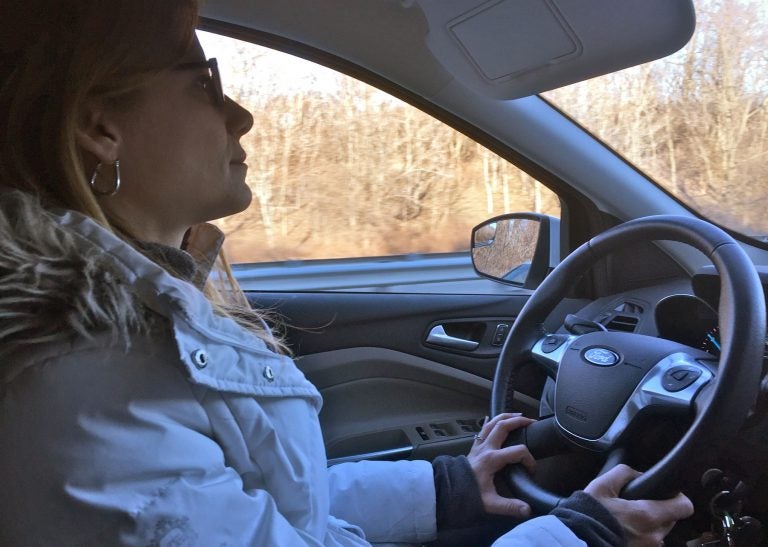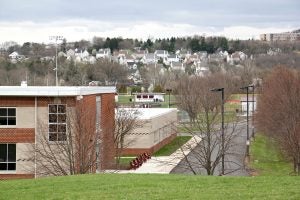‘The money shot’: How school districts find and prove residency fraud
Many districts monitor students to make sure they actually live within district boundaries and aren't using a fake address, but what does that monitoring actually entail?
Listen 6:40
Private investigator Tina Blanchette rides around on a surveillance mission. (Avi Wolfman-Arent/WHYY)
Every year, hundreds of kids are kicked out of suburban Philadelphia school districts for residency fraud. Maybe even thousands. This little-discussed corner of the K-12 landscape contains so many of the issues that shape education in Pennsylvania today.
WHYY explored the topic of disenrollment in our series, “Kicked Out.” This is part two. You can read part one here, about how some school districts in the Philadelphia suburbs are disproportionately removing students of color.
To listen to the radio version of this story, click on the play button above.
—
On a recent weekday afternoon, Tina Blanchette is doing what a lot of moms do on weekday afternoons: waiting in a suburban parking lot for a kid to arrive.
While idling in her inconspicuous, white SUV, we chat about her interests (“Game of Thrones,” audiobooks) and her three children (precocious, perpetually overscheduled). Midway through a sighing soliloquy about travel soccer, Blanchette spots a Lexus as it scoots past us.
Her voice drops to a whisper.
“That’s our boy…”
Here is where Blanchette’s parking-lot loitering takes a turn from the ordinary. She whips out a small camcorder and films a teenage boy as he steps out of the Lexus and into a two-story townhome.
“The closer he comes, the better for me,” Blanchette says aloud. “Totally our kid.”
When she isn’t shuttling kids to practice or binge-watching HBO, Blanchette is a private eye.
She wanted to be a ballerina. After an injury and career detour, she eventually became a secretary at the West Chester firm ELPS Private Detective Agency, filing paperwork, answering phones, and overhearing incomplete tidbits of ongoing cases.
“I’d be listening, and I’d be like, ‘Ahh, I wanna figure out,’ ” she says. “ ‘I want to get online. I want to run the data searches.’ ”
Eventually her boss, Jeff Stein, gave her that chance. Blanchette spends a lot of time tailing unfaithful spouses or catching workers who lie about their injuries to collect disability checks. Stein specializes in criminal defense work.
“Most of my clients are in prison for murder,” he says, with the flat affect of a practiced detective.
Recently, though, he’s gotten more work from local school districts.
“I would say in the last five years, there’s been an increase,” Stein says. “You’re seeing more private investigators get involved in this.”
There are 63 school districts in the four collar counties surrounding Philadelphia, and nearly all of them spend time and money making sure students from outside the district don’t try to sneak in. Enforcement is necessary, administrators say, to ensure that legal residents — and legal residents alone — receive the benefits of their tax dollars. Several district officials said they’ve increased their vigilance in recent years. And the trend isn’t limited to Pennsylvania. Districts around the region — from Washington, D.C. to New Jersey — use private investigators.
The cost of residency enforcement
Stein ties the uptick to financial stress caused by the great recession. With dollars tight, he says, school districts felt compelled to crack down on fraudsters. If Stein’s private eyes can prove a student lives outside district boundaries, that’s one less student the district has to pay to educate.
Others think the tightening economy caused more household disruption and, thus, more displaced parents looking for ways into higher-performing school districts.
“The economy has displaced families resulting in multiple occupancies, intergenerational residencies, things of that nature,” said Samuel Lee, superintendent of the Bensalem School District in Bucks County. “I don’t think that’s unique to us.”
Over the last 14 months, Stein estimates his firm has conducted 20 investigations and uncovered 10 students whose families lied about their address to sneak into a school district.
With many suburban districts paying $20,000 per pupil, Stein estimates that removing 10 students could save a district $200,000. His services cost less, somewhere between $750 and $4,000, depending on the length of the investigation, which can take between 10 and 60 hours of detective work.
The reality is likely more complex than Stein’s back-of-the-napkin math. A district would need to remove scores of students in order to reduce labor costs, and, even then, taxpayers would still be stuck with less fungible expenses such as building maintenance.
“We’re not moving out thousands of children,” said Lee Ann Wentzel, who runs the Ridley School District in Delaware County. “To really make a … major fiscal impact, you’re going to have to move out a big block of children.”
Still, districts might have a fiscal incentive to enforce the rules. Publicized vigilance can deter families from trying to cheat the system, just as lax enforcement could eventually result in a financially significant flood of students from out of district.
“It’s a deterrent,” said David Woods, superintendent of the Oxford Area School District in Chester County. “The fact that we do check up serves as a deterrent to folks that don’t live here who want to play with the system.”
Some administrators, including Frank Bruno with the William Penn School District in Delaware County, want to publicize their enforcement as much as possible.
The district employs someone who works exclusively on residency enforcement and more recently, purchased a software package called CLEAR, typically used by police departments, that allows staffers to sift through credit bureau reports, utility payments, and other public records to nail down where families live. Bruno, who heads the National Association of Pupil Services Administrators, believes more districts locally are hiring staff and paying for software to help them monitor for residency fraud.
When WHYY asked districts whom they employed to conduct residency cases, the answers ran a large and confusing gamut.
Some employed “home and school visitors” who kept an eye on potential fraudsters. Others had “school attendance officers,” “truancy officers,” “registrars,” “child accounting specialists,” social workers, or even superintendents whose duties included conducting investigations. Districts employed anywhere between one and six people who spent some time looking into residency concerns, with salaries ranging from around $40,000 per person annually to over $150,000.
That doesn’t include outside contractors like ELPS Private Detective Agency. Through a series of Right-to-Know requests, WHYY found 17 districts in the four major Pennsylvania counties outside Philadelphia that paid private investigators over the last three years.
| DISTRICT | AMOUNT PAID TO PRIVATE INVESTIGATORS (2014-2017) |
| Ridley | $56,125 |
| Penn-Delco | $55,275 |
| Interboro | $42,375 |
| Cheltenham | $36,302 |
| Tredyffrin-Easttown | $32,672 |
| Wissahickon | $28,563 |
| Haverford Township | $21,078 |
| Upper Moreland | $14,745 |
| Pottsgrove | $12,674 |
| Springfield (Delaware County) | $7,975 |
| Radnor | $6,579 |
| Downingtown Area | $6,125 |
| Central Bucks | $5,513 |
| Unionville-Chadds Ford | $4,754 |
| Perkiomen Valley | $4,750 |
| Octorara Area | $1,628 |
| Oxford Area | $157 |
By the standards of a school district budget, the amounts are small. But some, like Holli Morrison Street, question whether districts should spend anything on surveillance. Street, a mom in the Interboro School District, said district employees surveilled her house for weeks after she moved in with her parents. She’s as upset about their paycheck as she is the task they performed.
‘It is their burden to prove it’
Clearly, though, districts feel compelled to spend at least some resources on residency enforcement.
School administrators working with ELPS give the agency the name and photograph of a child they suspect lives outside the district. Blanchette uses database software to turn up potential addresses for the child’s family, and then she spends hours camping out at those addresses and tailing the student home from school to establish a pattern. Blanchette says she’s followed students as young as first grade.
This may sound creepy, but even Maura McInerney, an attorney and advocate for accused families, supports the idea of surveilling alleged fraudsters. She’d rather districts gather solid evidence than bring flimsy cases based on tipster hunches.
“It is their burden to prove it,” McInerney said. “And it is their duty to ensure they are not disenrolling children who actually do reside in their school district.”
After gathering enough visual evidence to establish a primary residence, Blanchette writes a report on her findings and gives the information to the contracted school district. From there, her involvement in the case ends, and the district decides what to do with the intel.
Typically, districts send written notifications to families they suspect of residency fraud, like the one below from the Cheltenham School District in Montgomery County. In some cases, these notes include invoices informing parents how much the district could legally charge them for services stolen. At least one district in New Jersey and another in suburban Pennsylvania has forced families to pay back tuition, though most districts told WHYY they typically don’t collect on these payments. Advocates believe the calculations are mostly used as a warning shot.
Waiting and watching
To gather the necessary physical evidence, Blanchette does a lot of waiting and watching.
On our recent surveillance mission, Blanchette begins by parking outside the school the student attends just prior to dismissal. (We’re withholding the name of the school and district per an agreement with ELPS.)
She’s looking for a particular car, a Honda CR-V, that she believes belongs to the student’s mother. We’re at the tail end of this investigation and Blanchette knows the student’s routine down to the minute. She thinks the student will return home around 3:27 p.m., so when the Honda fails to arrive at the expected time, she plays a hunch and speeds toward the house she believes to be the boy’s primary residence.
After about 10 minutes, she pulls into a quiet subdivision of identical row homes situated just outside district lines. The houses here are modestly priced, selling for around $200,000, which, Blanchette says, makes them about $40,000 cheaper than similar houses right across the road. That’s because this subdivision sits inside a school district where students score markedly worse on standardized tests and graduate at lower rates. The higher-achieving district also has fewer students in poverty and is overwhelmingly white, while students in the lower-achieving district are mostly students of color.
She parks a couple hundred feet away from the house identified as “the target residence” and waits for the student to come home.
Blanchette’s hunch pays off when the Lexus pulls up and out steps a scrawny, brown-haired teenager. It appears the boy’s mother didn’t drive him home today, leaving the job to a friend.
Blanchette films him entering the house and then waits for more action. She needs to capture him at different times of the day, and it helps her case if she can catch him doing something domestic, something that proves he lives at the house.
Fortune smiles on Blanchette a few minutes later when the boy walks out with a bag of trash that he takes behind the house.
“That’s the money shot right there,” Blanchette says excitedly. “That’s what we call the money shot in the investigative world, when you catch the person where you wanna catch them.”
Ten minutes later, Blanchette gets another coveted shot, this time of the boy taking his dog out onto the lawn for a quick bathroom break. She drives a bit closer and zooms in on his face, proving beyond doubt she’s found the right kid.
“I saw his face clear as day,” Blanchette says before folding the camera up and storing it on her dashboard.
Blanchette likes her job, mostly because it’s unpredictable, but also because she gets to bust sleazy spouses and deceptive employees.
As she heads back toward the office, though, and the high of a successful surveillance starts to fade, Blanchette admits she doesn’t always love residency work.
“This is one of the times in the job where you sort of have to separate yourself from the emotional aspect of it,” she explains, “because this kid’s gonna get kicked out of our district.”
The student she tailed today is smart and well-liked, Blanchette says. Soon, he’ll be slotted into a school he doesn’t know, in a district where statistics suggest he’s less likely to succeed. The mom in the white SUV understands there’s a whiff of injustice here. But the private eye in the inconspicuous car reminds me, and perhaps herself, there’s also a bigger picture.
What about the taxpayers who shell out extra money to live in a better school district? What about the district that needs to balance its budget?
“I feel bad for the kid, but they’re cheating the system,” she says.
The system looks like this: 63 school districts in the Pennsylvania suburbs outside Philadelphia. Separating high quality from low. Rich from poor.
Blanchette knows, it’s a system someone might be tempted to cheat.
—
 WHYY is one of 19 news organizations producing Broke in Philly, a collaborative reporting project on solutions to poverty and the city’s push towards economic justice. Follow us at @BrokeInPhilly
WHYY is one of 19 news organizations producing Broke in Philly, a collaborative reporting project on solutions to poverty and the city’s push towards economic justice. Follow us at @BrokeInPhilly
WHYY is your source for fact-based, in-depth journalism and information. As a nonprofit organization, we rely on financial support from readers like you. Please give today.







